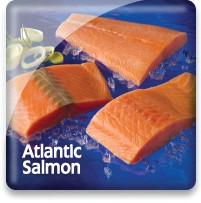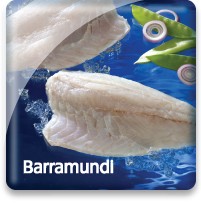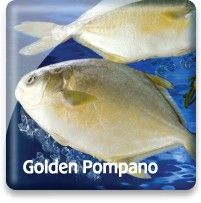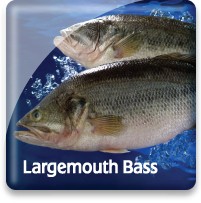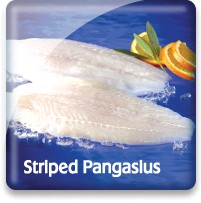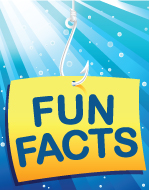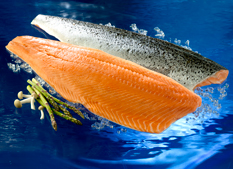
Atlantic Salmon

Market Name: Eating QualitiesRed to pinkish meat, Atlantic salmon is moist and oily. The taste is delicate and is an excellent source of Omega-3 polyunsaturated fatty acids, which have been proved to be great for the heart. The fish is also favored by many smokers for the quality of product it allows. It looks attractive in a retail display as a dressed fish or as steaks and fillets.
More than 3 billion pounds of farmed salmon is produced worldwide each year, far more than the total amount of wild salmon caught.
|
Description & CharacteristicsAtlantic salmon is the only salmon species whose natural home is in the waters of the Atlantic Ocean, as all other salmon species are native to the Pacific. The Romans were first to give Atlantics their familiar vernacular “salmon.” Their Latin name, Salmo salar, literally means “leaping salmon.” A fish that once thrived in the wild, today is the most important farmed salmon species. Wild stocks used to extend from New England up through Ungava Bay in Canada and from the White Sea in Russia down through Portugal. Remaining stocks are now reserved for recreational anglers.The domestication of salmon has been extremely successful, and farming takes place in the Atlantic, Pacific, and even small parts of the Indian Ocean. The pioneers of the salmon farming industry are the Norwegians and by means of their innovation and marketing, salmon farming has grown to a flourishing multibillion dollar business. Today, Chile has recovered from their disease problems that occurred in 2008 due to the disease ISA (Infectious Salmon Anemia) and has bounced back to being the #2 top producer in the world, just barely behind Norway. Chile is well on its way to overtaking Norway as the #1 producer of farmed Atlantic salmon. Chile is currently the top supplier of fresh Atlantic salmon fillets to the United States. Salmon is farmed in the open ocean, but before it is transported to these large pens, they are first grown in a freshwater hatchery on land. Eggs are bred from specially selected broodstock and mature into smolts which are identified as the “new year class.” These smolts, which live for a certain period in brackish water, are then transported and stocked in ocean pens. In these expansive pens, salmon are fed by high-tech feeding mechanisms. These mechanisms regulate the amount of feed by the salmon’s biomass. This ensures feed is not wasted or left to pollute the open sea. After several months of feeding, the salmon are harvested live and hauled to the processing plant. The farming process can take between 18 to 36 months.Atlantic salmon is sold both fresh and frozen. Fresh salmon can reach most parts of the U.S. very quickly, and it is feasible to fly as little as 500 pounds almost anywhere. Frozen salmon products, especially portions, have enjoyed increasing acceptance in the market, and since they do not have to be air-shipped, costs are lower. Wild Pacific species are readily available in the summer months, so farmed Atlantics dominate the market in the winter and spring when the wild fish cannot be supplied in fresh form in any significant quantity. Atlantic salmon is also highly valued by both cold and hot smokers especially in Europe.
Farmed salmon are usually harvested between six and 12 pounds. It is graded whole 6-8 lbs, 8-10 lbs, 10-12 lbs, 12-14 lbs, 14-16 lbs and 16-18 lbs. Farmed fillets are graded 1-2 lbs, 2-3 lbs, 3-4 lbs and 4-5 lbs. The flesh of the farmed Atlantic salmon is deep pink to red and has moist, large flakes. Flesh color is also controlled by feed pigments. The skin color is silver and distinguished by small black crosses. These crosses do not cross their lateral line, and this is one way to distinguish Atlantics from Steelhead trout which they are sometimes mistaken for.
Other Resources |
Handling Instructions for Atlantic Salmon
Our frozen Atlantic salmon should be stored at or below 0°F (-18°C) and then thawed properly when ready to cook. Our salmon portions and skin-on fillets are individually vacuumed packed to provide single serve convenience and to protect against freezer dehydration. The frozen shelf life of our Atlantic salmon is 12-18 months. Links to proper handling of seafood: NOAA - Fish Watch: Handling Seafood and A Consumer Guide to Safe Seafood Handling.
Thawing Atlantic Salmon
Atlantic salmon portions and fillets should be removed from their vacuum packed bags, placed in a
tight fitting plastic bag or covered container and placed under refrigeration between 33 and 39°F until they are completely thawed. This thawing process takes between 12 and 24 hours to be completed.
Important Instructions for Atlantic Salmon
Upon thawing, the Atlantic salmon should be gently rinsed with cold clean water. Thawed Atlantic salmon should be consumed immediately or continued to be held under proper refrigeration (33 to 39°F) and consumed within 2-3 days.
The Federal Food, Drug and Cosmetic Act now requires that all foods that are not raw agricultural commodities and that contain a major food allergen be labeled to clearly identify the name of the food source form which the allergen is derived. (21 CFR U.S.C. 343(w)(1)). The act defines eight foods, and any ingredients derived from these foods as major food allergens: Fish, Crustacean Shellfish, Milk, Eggs, Tree Nuts, Peanuts, Wheat & Soybeans. The name of the food source that must be listed on the label for fish or crustacean shellfish must be the specific type of fish or crustacean shellfish. The market names of species of fish and crustacean shellfish should be used to identify the food source of these two major food allergens. If you intend to re-pack these seafood products, be sure the allergen is declared in either one of two ways:
1) Within the list of ingredients
or
2) In a separate “Contains” statement immediately after or adjacent to the list of ingredients.
Consult the Fish and Fishery Products Hazards and Controls Guidance, Fourth Edition, Chapter 19 for more detailed information on the labeling of food allergens.
Cooking Tips
Atlantic salmon can be prepared using a wide variety of cooking methods. Links to cooking tips and recipes.
Chile
A long, skinny country (2,700 miles long and 110 miles wide), Chile is a land of contrasts. From the Pacific Coast to the high, rugged Andes range that runs the length of the country, Chile has five unique climate zones and growing conditions that favor a wide range of agricultural and fisheries products.
In addition to being the world’s largest exporter of fresh grapes, plums, and fresh fish, Chile is the world’s second-largest producer of farmed salmon.
Wild capture fishery: In addition to such well-known products as Chilean sea bass (Patagonian toothfish), Chilean waters are rich with Merluza (also known as Hake); Congrio; Corvina; swordfish; mussels, scallops, king and snow crab, and surf clams. In addition, Chile is one of the world’s major producers of fishmeal.
Aquaculture: Over the past 20 years, Chile has emerged as an aquaculture powerhouse, becoming the world’s second-largest producer of salmon (Norway is the largest). Salmon species grown in Chile include Atlantic, coho (silver), and some king salmon, as well as steelhead trout). Because of the cool ocean current known as the Humboldt Current, Chile produces salmon in the extreme Southern regions of the Country—equivalent to Madrid and Rome in latitude! These regions are known as the Zona de Los Lagos (Lakes) and Extremo Sur (Extreme South), corresponding with Regions X and XI, and even reaching into Region XI.
China
With more than 1.3 billion people, China is today the world’s most populous country. With a growing economy fueling an appetite for seafood, China has begun importing seafood for in-country consumption, as well as exporting a great deal of its production. In fact, since 2002, China has continued to export more fish and fishery products than any other country in the world, with Japan, the United States, and the Republic of Korea as its main export markets.
Chinese distant water fishing activities started in 1985 when China gained access to new fishing grounds through agreements with foreign countries. China operates vessels in West Africa, the North Pacific, and tuna longline vessels in the South Pacific. In addition, squid are harvested in the Japan Sea and the North Pacific under Chinese-flagged vessels.
Carp are also commercially important, as are bream, shad, eel, cat fish, rainbow trout, salmon, whitebait, mullet, mandarin fish, perch, sturgeon, murrel and pangolin. Commercial shellfish include freshwater shrimp and river crabs, molluscs such as mussels, clams, scallops, and freshwater snails.
With one-fifth of the world’s population, and an official government policy to promote aquaculture, China has today become an aquaculture powerhouse, now producing more than two-thirds of the world’s aquaculture species. Fish and shellfish are grown in freshwater as well as the marine environment, including rivers, estuaries, inland lakes, ponds, and the sea.
|
*Click here for an explanation of our Sustainability Spectrum Sustainability AssessmentFarmed Atlantic Salmon is one of the most commonly reared species in aquaculture and one of the most popular seafood choices in the United States. Despite significant improvements and innovations in salmon farming practices over time, major environmental concerns remain. These include potential adverse impacts to seafloor habitats and water quality from salmon waste and uneaten feed; relatively high use of wild fish stocks in feed; the use of antibiotics to combat diseases such as salmon rickettsial syndrome and the use of other chemicals for antifouling and to treat sea lice infestations; and from disease transmission and competition occurring in the natural surrounding environment due to escaped farmed salmon. These same types of issues have existed for centuries in the production of livestock such as pigs, cattle, and poultry. Aquaculture, however, is improving its animal husbandry practices at a far faster rate than whatever occurred throughout the history of land based livestock production. The Chilean salmon industry has been noted in particular for having the highest use of chemicals and antibiotics. However, just like they changed their smolt production methods by not using freshwater lakes in order to confront infectious salmon anemia (ISA) that crippled the industry from 2007 to 2009, they are now confronting the overuse of antibiotics and pesticide use. The Global Aquaculture Alliance through its BAP (Best Aquaculture Practice) standards is actively confronting this concern along with the efforts of the Aquaculture Stewardship Council (ASC). GSI is a trade organization of several of the largest global salmon farming companies and its goal is to be 100% ASC certified by 2020. This should greatly advance the sustainability of this very important sector of the aquaculture industry. Recently, Seafood Watch has listed ASC certified farm raised salmon as a "Good Choice".
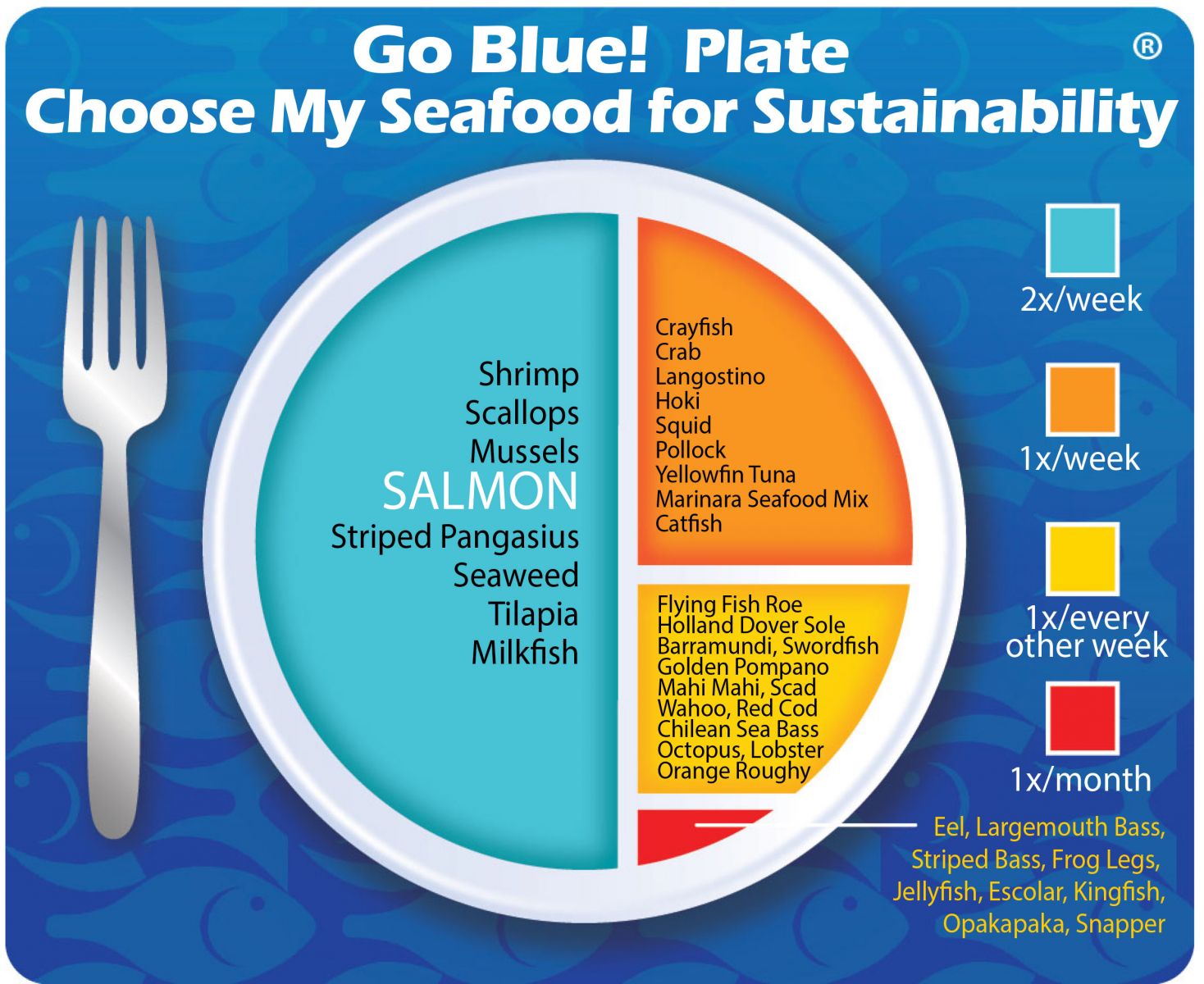
Environmental Impact: Moderate to HighMajor environmental concerns exist, including adverse ecosystem impacts from water pollution and salmon waste; issues associated with antibiotic and other chemical use; the use of wild fish stocks in feed; and impacts to wild salmon populations and other native species from disease transmission and salmon escapes.
Sustainability Improvements NeededSalmon farms need to implement best management practices to prevent or minimize environmental impacts, such as reducing stocking densities, properly siting farms, reducing the use of fishmeal and fish oil in feed, using vaccines and disease management strategies, and preventing escapes. Chile has moved from freshwater lakes to the closed-containment production of smolts and is rapidly improving their management practices by addressing antibiotic and chemical use. Advances in salmon feed formulations continue to make improvements in reducing the ingredient percentage of fish oil and fishmeal by finding substitutes produced from algae, grain crops, insects, worms, and even bacteria and fungi. The NOAA-USDA Alternative Feeds Initiative is assisting the aquaculture feed industry in their efforts.
Actions that Sea Port is UndertakingSea Port believes that farmed Atlantic Salmon relieves fishing pressure on the remaining wild salmon stocks thereby helping to sustain and protect them. Sea Port sources from the most progressive Chilean processors and salmon farms that are either emulating or participating directly with the Global Aquaculture Alliance or other certifiers to improve the sustainability of their feed, hatchery, grow out, and processing operations. Some Chilean Atlantic Salmon farms have recently achieved BAP certifications demonstrating the continual improvement that is underway in Chile at this time. Sea Port is a Governing Member of the Global Aquaculture Alliance and supports all their efforts to advance responsible aquaculture around the world. Sea Port believes that, in aggregate, choosing from a diverse variety of seafood is better for sustaining the world’s seafood resources and farmed Atlantic Salmon should be a part of this variety. We created the sustainability assessments for each of our seafood items in order to reveal the existing and potential environmental impacts and risks that are associated with producing them for human consumption. This allowed us to establish the starting position for each of our seafood items along our progressive Go Blue! Seafood Sustainability Spectrum®. These assessments are only a single snapshot in time and because of this, we will continue to assess and update the critical sustainability needs associated with our supply sources and issue updates to the Go Blue! Seafood Sustainability Spectrum® as needed. There is a growing global awareness for the need to assure the sustainability of farmed and wild caught seafood and because of this; all around the world positive changes are rapidly occurring at all levels of the seafood supply chain. We will continue to spread this growing awareness and work with our many industry partners to improve the sustainability of all seafood, which we believe is the ideal protein of choice to feed an ever growing world population. Our Go Blue! Seafood Sustainability Spectrum® serves as our compass and yardstick as we strive to move all our products forward to becoming more sustainable. Please join us in this committed quest and Catch Our Wave® to sustainability by choosing a diverse variety of responsibly produced seafood as part of your diet. |


